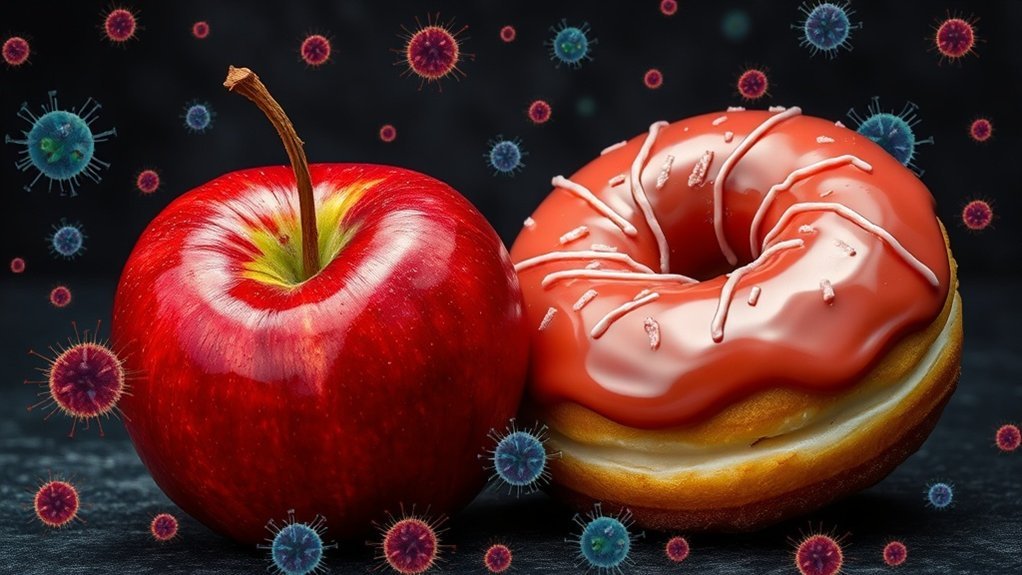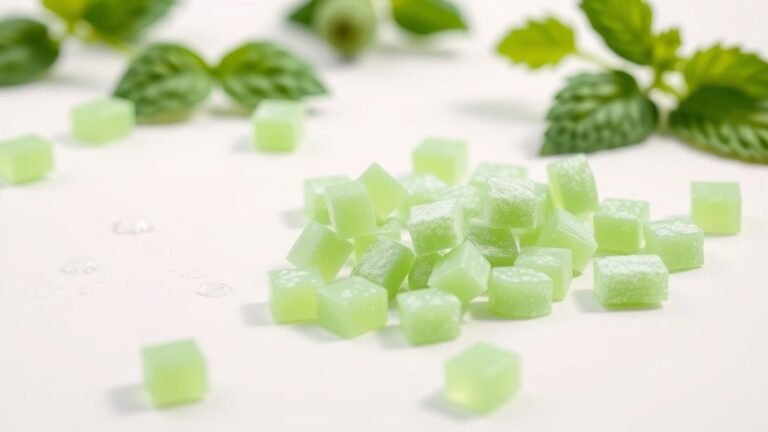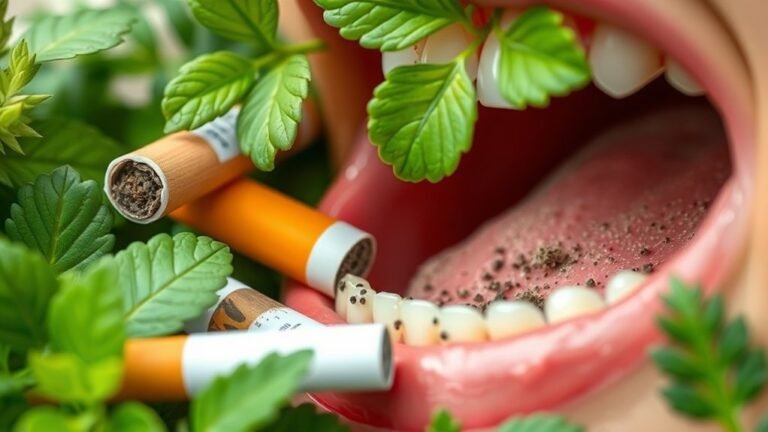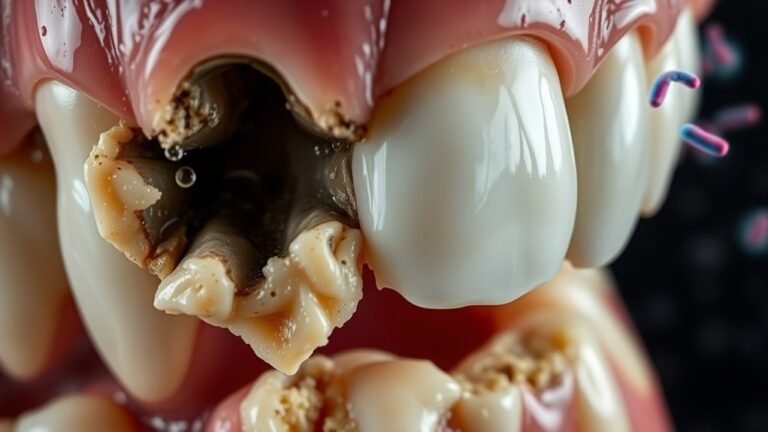How Do Sugary and Acidic Foods Increase Oral Bacteria Causing Decay
Sugary and acidic foods create a perfect environment for harmful bacteria in your mouth. When you consume sugar, bacteria thrive on it, producing acids that erode tooth enamel. Acidic foods further lower your mouth’s pH, amplifying enamel erosion and increasing sensitivity. This cycle of bacteria growth and decay can lead to serious oral health issues. Understanding how your diet affects these bacteria is essential to maintaining your dental health and preventing decay-related problems. There’s more to learn about effective preventive measures.
Key Takeaways
- Sugary foods provide a food source for harmful bacteria, leading to increased bacterial growth in the mouth.
- Bacteria metabolize sugars, producing acids that erode tooth enamel, heightening the risk of decay.
- Regular sugar exposure amplifies bacterial activity and accelerates the decay process in teeth.
- Acidic foods lower mouth pH, contributing to enamel erosion and creating an environment for harmful bacteria to thrive.
- The combination of sugar and acid fosters a cycle of decay, increasing sensitivity and further damaging oral health.
The Role of Sugar in Oral Health
Have you ever wondered how sugar impacts your oral health? Consuming sugary foods creates a breeding ground for oral bacteria. These bacteria thrive on sugar, producing acids as a byproduct. As these acids accumulate, they begin to erode your tooth enamel, leading to an increased risk of tooth decay. The more sugar you consume, the more these bacteria multiply, amplifying the decay process. Regular exposure to sugars, especially in sticky or prolonged forms, heightens your chances of cavities. To maintain ideal oral health, it’s essential to limit your intake of sugary foods and practice good oral hygiene. Remember, reducing sugar can notably decrease harmful oral bacteria and promote a healthier smile.
How Acids Affect Tooth Enamel
Acids in your diet can greatly impact the health of your tooth enamel. When the pH levels in your mouth drop due to acidic foods or drinks, enamel erosion can occur, leading to increased sensitivity and decay. Understanding the importance of remineralization can help you protect your teeth and maintain ideal oral health.
Enamel Erosion Process
When you consume foods and beverages high in sugars and acids, your tooth enamel can begin to erode, leading to increased vulnerability to decay. Acidic foods, such as citrus fruits and soda, lower the pH in your mouth, creating an environment that allows harmful bacteria, like Streptococcus mutans, to thrive. These bacteria produce more acids, further exacerbating enamel erosion.
| Stage of Erosion | Description | Impact on Teeth |
|---|---|---|
| Initial Erosion | Demineralization begins | Increased sensitivity |
| Advanced Erosion | More significant enamel loss | Higher decay risk |
| Severe Erosion | Exposure of dentin | Possible tooth loss |
Understanding this process can help you make informed choices about your diet and oral hygiene.
Ph Levels Impact
The pH level in your mouth plays an essential role in determining the health of your tooth enamel. When you consume sugary or acidic foods, the pH level drops, creating an acidic environment that can harm your enamel. This acidity can lead to the demineralization of your teeth, making them more susceptible to decay. Additionally, an acidic mouth encourages plaque buildup, as harmful bacteria thrive in lower pH conditions. This plaque can further exacerbate enamel erosion, leading to cavities and other dental issues. Maintaining a balanced pH is imperative for enamel protection. To safeguard your teeth, limit acidic and sugary foods, and consider rinsing with water after meals to help restore a healthier pH level.
Remineralization Importance
While you may not realize it, the process of remineralization is essential for maintaining your tooth enamel’s health, especially after exposure to acidic environments. When you consume acidic foods or drinks, enamel can lose minerals, making it more vulnerable to decay. Fortunately, remineralization helps restore these lost minerals, reinforcing your enamel.
| Process | Importance | Sources |
|---|---|---|
| Remineralization | Strengthens enamel | Calcium, phosphate |
| Saliva | Natural buffer | Maintains pH levels |
| Fluoride | Enhances remineralization | Found in dental products |
The Relationship Between Bacteria and Decay
Oral bacteria play an essential role in the development of dental decay, as they metabolize sugars and produce acids that erode tooth enamel. When you consume sugary foods, these bacteria thrive, rapidly multiplying and creating an acidic environment in your mouth. This acidity weakens the enamel, leading to demineralization and cavities. The balance between beneficial and harmful bacteria is vital; if harmful bacteria dominate, decay progresses. Regular oral hygiene, including brushing and flossing, helps maintain this balance by removing plaque and food particles. Additionally, limiting sugar intake decreases the food source for these bacteria, reducing acid production and protecting your teeth. Understanding this relationship can empower you to make better dietary choices and prioritize oral health.
Common Sugary and Acidic Foods to Avoid
To maintain your oral health, it’s vital to be aware of common sugary and acidic foods that can contribute to decay. Popular sugary snacks and acidic beverages can greatly increase your risk of cavities. Additionally, many processed foods contain hidden sugars that you might not expect, making it essential to read labels carefully.
Popular Sugary Snacks
Many of your favorite sugary snacks can contribute to dental decay and other oral health issues. Foods like candy bars, gummy candies, and marshmallows are particularly problematic due to their high sugar content. These snacks stick to your teeth and provide a breeding ground for harmful bacteria, leading to plaque formation. Additionally, sweet baked goods, such as cookies and pastries, often contain both sugar and refined carbohydrates, which can exacerbate the problem. Even seemingly innocent snacks like granola bars can be loaded with sugars that promote bacterial growth. To protect your oral health, it’s essential to limit your intake of these sugary snacks and opt for healthier alternatives like fruits or nuts that don’t encourage decay.
Acidic Beverage Choices
While you might enjoy an invigorating soda or a sweetened fruit juice, these beverages can greatly harm your dental health. Carbonated drinks often contain high levels of acidity, which can erode enamel, making your teeth more susceptible to decay. Similarly, fruit juices, despite their natural origins, frequently have added sugars and citric acid that contribute to an acidic environment in your mouth. Even seemingly healthy options like lemonade or iced tea can be detrimental due to their acidity and sugar content. It’s crucial to limit your intake of these drinks and consider alternatives like water or unsweetened herbal teas. Protecting your enamel and maintaining a balanced oral environment can considerably reduce the risk of cavities and other dental issues.
Hidden Sugars in Foods
Have you ever considered how hidden sugars in everyday foods might be sabotaging your dental health? These sugars can fuel harmful bacteria, leading to decay. You might be surprised to find sugary ingredients lurking in products you think are healthy. Here are three common culprits to watch out for:
- Fruit juices: Often marketed as healthy, they can contain as much sugar as soda.
- Yogurt: Flavored varieties can pack in sugar while masking the benefits of probiotics.
- Granola bars: Many are loaded with sweeteners, making them less nutritious than you think.
The Impact of Diet on Oral Bacteria Levels
Diet plays an essential role in shaping the levels of oral bacteria, influencing both the composition and abundance of microbial communities in your mouth. Foods high in sugar and acid can promote the growth of harmful bacteria, leading to an imbalance that increases the risk of decay. Conversely, a balanced diet rich in fiber, vitamins, and minerals can support beneficial bacteria that help maintain oral health.
| Food Type | Impact on Oral Bacteria |
|---|---|
| Sugary Snacks | Increases harmful bacteria |
| Acidic Fruits | Lowers pH, promotes decay |
| Whole Grains | Supports beneficial bacteria |
| Leafy Greens | Helps neutralize acids |
Understanding how your diet affects oral bacteria is vital for maintaining a healthy mouth.
Preventive Measures for Maintaining Oral Health
Maintaining oral health goes beyond just monitoring your diet; it involves implementing a variety of preventive measures. By actively taking care of your teeth and gums, you can greatly reduce the risk of decay and infection. Here are three essential measures to contemplate:
- Brush and Floss Daily: Use fluoride toothpaste and a soft-bristled toothbrush to clean your teeth at least twice a day. Don’t forget to floss to remove food particles and plaque between teeth.
- Regular Dental Visits: Schedule check-ups every six months for professional cleanings and early detection of potential issues.
- Limit Sugary and Acidic Foods: Be mindful of your intake, as these foods can promote harmful bacteria growth and weaken enamel.
Long-Term Effects of Poor Dietary Choices on Teeth
While you may enjoy indulging in sugary snacks and acidic beverages, the long-term effects of these dietary choices on your teeth can be detrimental. Over time, sugar serves as fuel for harmful bacteria in your mouth, leading to increased acid production. This acid erodes tooth enamel, making your teeth more susceptible to decay and cavities. Additionally, acidic foods and drinks can weaken enamel directly, exacerbating the problem. As enamel wears away, you may experience heightened sensitivity and discoloration. Furthermore, poor dietary choices can contribute to gum disease, which can further compromise your oral health. To maintain strong, healthy teeth, it’s essential to limit sugary and acidic foods and prioritize a balanced diet rich in nutrients that support oral health.
Frequently Asked Questions
Can Brushing Teeth After Eating Sugar Prevent Decay Effectively?
Brushing your teeth after eating sugar can help prevent decay, but it’s essential to wait about 30 minutes. This allows saliva to neutralize acids, reducing enamel erosion while effectively removing sugar and bacteria from your mouth.
How Long Do Sugary Substances Stay on Teeth?
Sugary substances can linger on your teeth for up to 20 minutes after consumption. During this time, bacteria feed on the sugars, increasing the risk of decay if proper oral hygiene isn’t practiced promptly.
Do Artificial Sweeteners Affect Oral Bacteria Levels?
Artificial sweeteners don’t feed oral bacteria like sugars do, but they can still influence your mouth’s ecosystem. It’s ironic, isn’t it? You might think they’re harmless, yet they can subtly alter bacteria levels.
Is It Safe to Consume Acidic Foods in Moderation?
Yes, it’s safe to consume acidic foods in moderation. Balancing your diet with neutralizing foods and maintaining good oral hygiene helps minimize any potential negative effects on your dental health from occasional acidity.
How Does Saliva Help Combat Sugar and Acid Effects?
Saliva’s like a superhero for your mouth! It neutralizes acids, washes away sugars, and supplies essential minerals to strengthen enamel. This natural defense helps prevent decay, keeping your teeth and gums healthy amidst daily challenges.
Conclusion
To sum up, your diet directly influences your oral health. Just like a garden needs the right nutrients to flourish, your mouth requires balanced foods to thrive. A study found that diets high in sugar and acid can double the risk of tooth decay. By choosing healthier options and limiting sugary snacks, you can cultivate a healthier oral environment, keeping decay at bay. Remember, your teeth aren’t just tools; they’re an essential part of your overall well-being.






